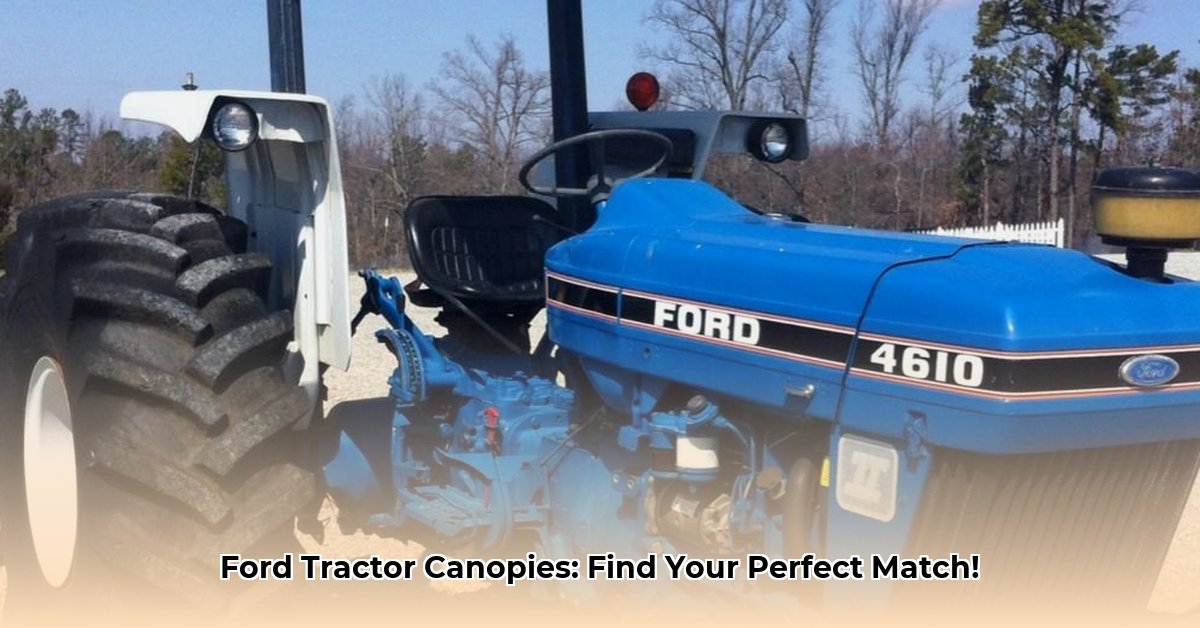
Identifying Your Ford Tractor Model and Cab Type
Before you begin searching for a canopy, accurately identifying your Ford tractor's model and cab type is crucial. The right canopy depends entirely on this information. Incorrect identification could lead to a considerable waste of time and money. For more information on older Ford tractor models, check out this helpful resource: Ford Tractor History.
Locate the Serial Number: This unique identifier is usually found stamped on a metal plate. Common locations include near the steering column, under the hood, or on the tractor's frame. Take a clear photo for reference.
Find the Model Plate: This plate will display your tractor's model number and other key specifications. It’s often located near the serial number plate. Again, a picture is worth a thousand words.
Determine Your Cab Type: This is a critical step often overlooked. Ford tractors come in two main cab styles: Utility/All-Purpose and Row Crop/Flat Deck. Utility cabs typically have a sloped floor, while Row Crop cabs feature a flat floor. Canopy design varies significantly between these types. Confirming your cab type ensures a proper fit.
Understanding Canopy Types and Features
Several canopy options exist to suit various needs and budgets. Understanding the differences is key to making the right choice.
Full Cabs: These provide complete enclosure, offering maximum protection from sun, rain, wind, and debris. They’re the most expensive option but provide the best overall protection. Think of them as a climate-controlled workspace for your tractor.
Partial Canopies: These offer overhead protection, primarily shielding the operator from sun and rain. They are generally more affordable than full cabs but offer less comprehensive protection.
ROPS (Roll Over Protective Structures): While not strictly canopies, ROPs are vital safety features designed to protect the operator in the event of a rollover. They form the basis for many canopy installations. Never operate a tractor without a properly functioning ROPS.
Finding and Purchasing Your Ford Tractor Canopy
Once you've identified your tractor and determined your needs, you can begin your search for the perfect canopy. Two main avenues exist: Original Equipment Manufacturer (OEM) and aftermarket options. Each has its own set of advantages and drawbacks.
OEM Canopies (Ford or Authorized Dealers): Sourcing your canopy directly from Ford or an authorized dealer guarantees a perfect fit and often includes a warranty. This is the most reliable but often most expensive route.
Aftermarket Canopies: A wider array of choices and potentially lower prices are available from various online marketplaces and agricultural supply stores. However, thorough verification of compatibility with your specific Ford tractor model and cab type is extremely important to avoid compatibility issues. Don't underestimate the time required to ensure a proper fit.
Comparing Canopy Features: A Checklist
Before making a purchase, consider these essential features:
- Materials: Steel offers exceptional durability, while lighter materials like aluminum or polycarbonate might be more suitable depending on your climate and workload. Check for rust resistance, UV protection, and overall strength.
- Durability and Longevity: Examine online reviews and ratings to gauge the long-term performance of potential canopies. This is a significant factor influencing your overall cost.
- Installation Ease: Check for clear instructions and the availability of necessary mounting hardware. A complex installation process may add significantly to your overall cost and burden.
- Visibility: Ensure the canopy doesn't impede your view while operating the tractor. Safety is paramount!
Canopy Installation: A General Overview
Installing a canopy can range from simple to moderately complex depending on the model and your mechanical aptitude. Always consult the manufacturer's instructions. Safety precautions are crucial: disconnect the tractor's battery before starting any work. Professional installation is always an option if you're unsure about any aspect of the process.
Canopy Maintenance and Care
Regular maintenance is key to extending your canopy’s lifespan. This includes periodic cleaning, checking for damage (tears, rust, loose fasteners), and lubricating any moving parts as needed. Preventing damage is considerably less expensive than repairing it.
Conclusion
Finding the right canopy for your Ford tractor involves a systematic approach. By carefully identifying your tractor's model and cab type, understanding canopy options, and diligently comparing features, you can make an informed decision that optimizes both protection and value. Remember to prioritize safety during installation and regularly maintain your canopy to ensure its longevity. If you have further questions, please feel free to leave a comment below.